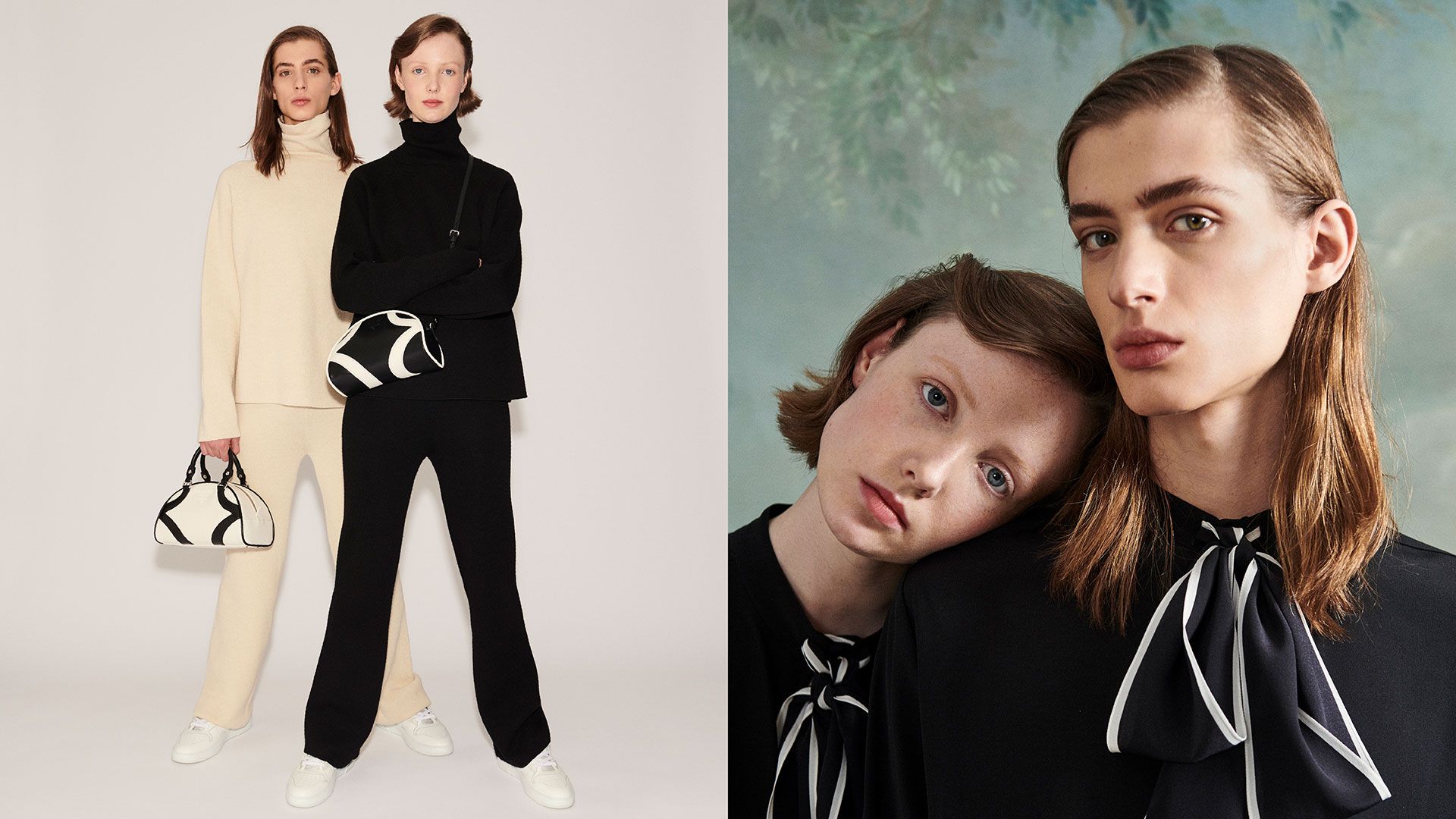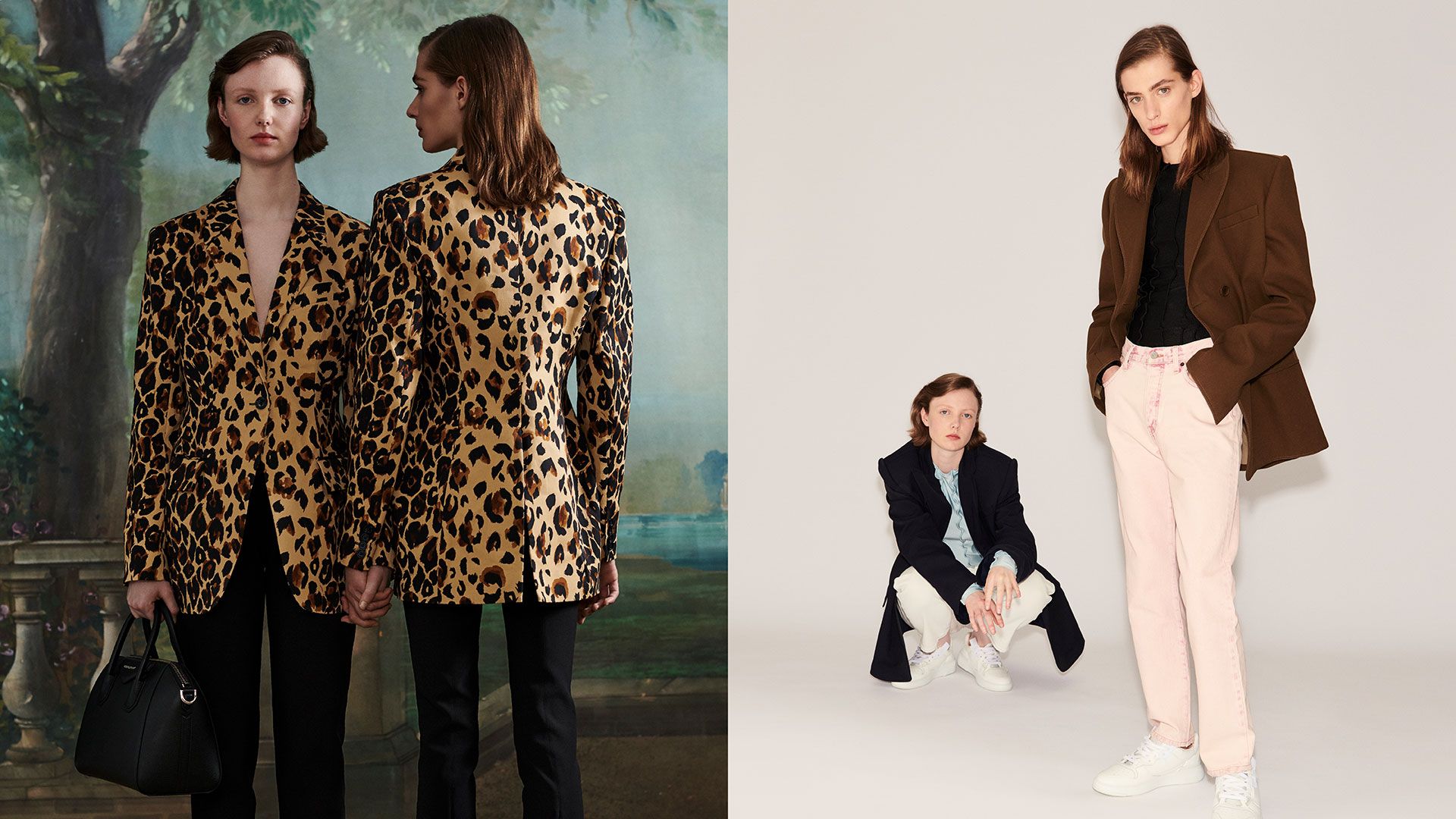-
TO EACH THEIR OWN GENDER
Creative and Style Director, Yann Weber. Photographer, Raffaele Cariou. Producer, Guillaume Folliero de Luna. Models, Asta Stensson and Cyryl Smolenski. Hair Stylist, Olivier Schawalder. Make-up Artist, Caroline Fenouil.

Her: Custom Made shirt. Him: Custom Made shirt.
A man or a woman: this has long been the limited perception of gender. The dichotomy between these two poles has been established as the norm with nothing else existing around it, thus representing the foundation on which our society remains deeply rooted. However, according to a YouGov poll carried out last March for L'Obs, 14% of 18-44 year olds state that, strictly speaking, they don't feel as if they belong to either the male or female gender. Increasing in number and gaining more visibility, these individuals present themselves as "non-binary," asserting a variety of different identifications. Whether identifying as "transgender" (having a gender identity that differs from the sex assigned at birth), "gender free" (moving between genders) or "agender" (i.e. refusing to identify with any one gender), all seek to legitimise the existence of alternative conceptions. The concept of binary when referring to gender, in social science, showcases that these parallel pathways are a form of liberation from the constraints of this polarity. Gender could be viewed as a multicoloured spectrum of endless nuances. Described as "no gender", this approach, where genders can vary and merge, is attracting more and more business sectors, questioning the need to classify their products according to an ingrained, yet increasingly challenged, duality. Primarily present in the fashion, perfume and cosmetics industries, as well as the toy industry (Barbie creator, Mattel, has just launched a range of gender-neutral dolls), cinema and, more recently, cosmetic surgery are following their lead. More than just a trend, this fundamental shift reflects a gradual change in mindsets. An indication of how the wall separating gender into two categories is crumbling away, making way for equality and inclusiveness.
Left. Him: Carcel sweater, Carcel pants, Prada bag, Givenchy Sneakers. Her: Carcel sweater, Carcel pants, Givenchy Sneakers, Prada bag. Right. Her: Givenchy shirt. Him: Givenchy shirt.
FASHION: A PIONEER IN DECONSTRUCTING GENDER STEREOTYPES
Known for its avant-garde approach and ability to reflect changes in society before they are even apparent, the fashion industry was one of the first sectors to question the gender binary. As early as the 1980s, fashion designers such as Jean-Paul Gaultier began to blur the lines of femininity and masculinity, switching stereotypes to create androgynous silhouettes. Typically seen as feminine in character, corsets were wrapped around men's torsos, while women graced the runways in trouser suits, a symbol of power and the patriarchy's favourite attire. "I like to reverse roles, breaking established codes that no longer make sense today. I don't believe that fabrics have a gender, any more than certain garments do," reflected Jean-Paul Gaultier, speaking in 2015 at the Grand Palais in Paris. "Une fille au masculin; un garçon féminin" sang Indochine in the 1985 chart hit 3ème sexe, later used by the designer for one of his advertising campaigns in 2008. In 1985, during his show "Et Dieu créa l'homme" (And God Created Man), echoing Saint Laurent's women's tuxedo jackets, Jean-Paul Gaultier also launched a skirt for men.
Left. Her: Mugler jacket, Mugler pants, Givenchy Sneakers, Givenchy bag. Him : Mugler jacket, Mugler pants, Givenchy Sneakers, Givenchy bag. Right. Her: Jacket Antidote, Shirt Antidote, Jeans Levi's, Givenchy Sneakers. Him: Jacket Antidote, Shirt Antidote, Jeans Levi's, Givenchy Sneakers.
In the 1990s, this ambition to deconstruct gender stereotypes continued with the launch of Calvin Klein's unisex fragrance, named "CK One", overturning the very binary world of perfumery. With mixed runway shows becoming more mainstream, this approach is now peaking and being adopted by labels such as Random Identities. Launched in 2017 by the Italian designer Stefano Pilati, irrespective of its customers' gender, the brand offers heeled boots, skirts, dresses as well as trousers and shirts overprinted with a bra motif. A logical positioning when you consider that, according to a study by the American advertising agency J. Walter Thompson, 56% of Generation Z consumers have already bought clothes outside their specific gender section. Enough to support the choice of Adieu and Ambush, two further labels from the worlds of shoe design and jewellery respectively, turning towards unisex collections. Telfar Clemens, a young fashion designer based in New York, is also considered as one of the forerunners of this current gender free movement after succeeding in getting men to embrace the handbag.
Him: Shirt Y/Project, Carcel pants, Givenchy Sneakers. Her: Dress Acne Studios, Carcel pants, Givenchy Sneakers.
Aside from fashion, gender neutrality is experiencing an unprecedented surge in popularity in the world of cosmetics. Despite continuing to be predominantly aimed at women, this industry was already rocked in the ‘70s and ‘80s by David Bowie and Boy George's androgyny. For several years now, make-up brands offering products for both men and women have been growing in number. This development mirrors the emergence of a host of influencers on YouTube and Instagram such as James Charles and transgender YouTuber Nikita Dragun, who use make-up to express and affirm their individuality, breaking down the gender binary in the process.
CHANGING MINDSETS, MOVING WITH THE TIMES
An innovative, almost revolutionary, approach? This is more of a return to the future: make-up, along with heels, jewellery, lace and long wigs— made popular again by Kylie Jenner—have not always been reserved for women. The proof can be found in various paintings portraying King Henry III and his minions, Louis XIV, the Duke of Buckingham and others. Pearl-draped necklines and studded ears, ribbon-embellished heeled shoes along with delicately sculpted metal buckles, stockings, petticoat breaches and more. Flamboyant and refined, these items, iconic of the male attire of 16th and 17th century nobility, subsequently became symbols of femininity, and thus the antithesis of virility. This shows how our perception of masculine and feminine is changing, also telling us that our criteria for gender differentiation is arbitrary.
Left. Elle: Jacket Burberry, Shirt Burberry, Skirt Burberry, Burberry bag, Heels Burberry. Him: Shirt Burberry, Burberry sweater, Burberry pants, Belt bag Burberry, Shoes Burberry. Right. Her: Carcel sweater, Jean Carne Bollente, Moschino belt, Givenchy Sneakers. Him : Carcel sweater, Jean Carne Bollente, Moschino belt, Givenchy Sneakers.
The shift in trend, still a clear influence, can be attributed to the period running from the end of the 18th century and throughout the 19th century, when fashion progressively became more reserved for women. In Émile (1762), Rousseau writes as follows "Women, for their part, are coquettish," adding that "little girls, almost from birth, love finery". Magazines of the time also contributed to reinforcing these ideas. Consequently, men who dared to challenge this sexual polarization of appearances became targets of repeated homophobic criticism. As is the case of the "Macaroni" in England, reproached in 1770 by The Oxford Magazine for being "neither male nor female," appearing in eccentric outfits and challenging the dress code of the time. In the 1780s, prior to asserting its dominance, the concept of the men's suit was introduced, now paradoxically central to unisex fashion. "Sober and dark clothing, morning suits and other frock coats, exclude men from the world of now feminine ostentatious clothing," wrote Denis Bruna and Chloé Demey in their book A History of Fashion and Clothing. To name this phenomenon, the British psychoanalyst John Carl Flügel talks about the "Great Masculine Renunciation". Founded in 2015 by Spanish Alejandro Gómez Palomo, the Palomo Spain label appears to be trying to return to this era prior to its impoverishment. Colourful and lavish, its designs pay homage to styles of the past, and the feminization of the male wardrobe, as if to liberate men from the myth of virility.
Left. Her: Shirt Acne Studios, Carcel pants, Givenchy sneakers. Him: Shirt Y/Project, Carcel pants, Givenchy sneakers. Right. Her: Trench Givenchy, Givenchy pants, Givenchy bag. Him: Trench Givenchy, Givenchy pants, Givenchy bag.
RESETTING GENDER CODES
Relaxed by the types of initiatives now gaining ground and extending to other areas, standard representations of the gender binary, are gradually alleviating the pressure on the younger generation. Embodying the future, the LGBTQI+ community is playing its part in shifting these dividing lines, notably through its demands voiced each year during Pride. Following Canada and Australia, the municipality of New York introduced a gender-neutral birth certificate at the start of 2019. While this initiative remains limited compared to the 50 or so gender options offered by Facebook, it is nevertheless an important step forward in creating a non-binary society. In addition, neutral pronouns such as "iel" (a contraction of "il" and "elle") in French, and the use of "they" in English are becoming more popular.
Left. Her: Shirt Givenchy, Givenchy pants, Givenchy sneakers. Him: Shirt Givenchy, Givenchy pants, Givenchy sneakers. Right. Her: Shirt Custom Made .
More and more public figures are also embracing their "non-binary", "genderqueer" or "agender" identity, a sign of how the binary perception is changing. Leading the way is singer Sam Smith, actor Ezra Miller as well as Jaden Smith, who are no strangers to appearing in skirts at red carpet events. Like fashion, these celebrities are role models for countless millennials, helping to spread the new codes based around mixing up genders. At the same time, the music and film industries are progressively promoting a more open representation of gender. In 2017, Emma Watson received the non-gender "Best Actress or Best Actor" prize at the MTV Awards presented by non-binary actress Asia Kate Dillon, while in 2018, the Cannes Film Festival presented a gender-neutral performance award for the first time in its history to Belgian actor, Victor Polster, for his role in Girl. Celebrating this young talent from Belgian cinema, and more broadly, tolerance and inclusiveness, our society is giving multiple gender identifications much greater recognition.





